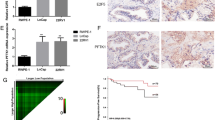Abstract
MicroRNAs have been implicated in regulating diverse cellular pathways. Emerging evidence indicates that miR-143 plays causal roles in cancer tumorigenesis as a tumor suppress gene; however, its role in prostate cancer tumorigenesis remains largely unknown. The aims of this study were to verify the effect of miR-143 on proliferation and migration abilities of prostate cancer cells. The expression level of miR-143 and its target gene KRAS were measured by realtime PCR and western blotting, respectively. Effects of miR-143 in cell proliferation, migration and chemosensitivity were evaluated by MTT assay, FACS cell cycle analysis, colony formation assay, and transwell migratory assay. Our results revealed an inverse correlation of expression between miR-143 and KRAS protein in prostate cancer samples (Pearson’s correlation scatter plots: R = −0.707, P < 0.05). Moreover, over-expression of miR-143 in prostate cancer cells suppressed their proliferation and migration and increased their sensitivity to docetaxel by targeting EGFR/RAS/MAPK pathway. These findings suggest that miR-143 plays an important role in prostate cancer proliferation, migration and chemosensitivity by suppressing KRAS and subsequent inactivation of MAPK pathway, which provides a potential development of a new approach for the treatment of prostate cancer.





Similar content being viewed by others
References
Jemal A, Siegel R, Ward E, Hao Y, Xu J, Thun MJ (2009) Cancer statistics, 2009. CA Cancer J Clin 59:225–249
Loberg RD, Logothetis CJ, Keller ET, Pienta KJ (2005) Pathogenesis and treatment of prostate cancer bone metastases: targeting the lethal phenotype. J Clin Oncol 23:8232–8241
Huggins C (1967) Endocrine-induced regression of cancers. Science 156:1050–1054
Feldman BJ, Feldman D (2001) The development of androgen-independent prostate cancer. Nat Rev Cancer 1:34–45
Ambros V, Bartel B, Bartel DP et al (2003) A uniform system for microRNA annotation. RNA 9:277–279
Lewis BP, Burge CB, Bartel DP (2005) Conserved seed pairing, often flanked by adenosines, indicates that thousands of human genes are microRNA targets. Cell 120:15–20
Liu CG, Calin GA, Meloon B et al (2004) An oligonucleotide microchip for genome-wide microRNA profiling in human and mouse tissues. Proc Natl Acad Sci USA 101:9740–9744
Volinia S, Calin GA, Liu CG et al (2006) A microRNA expression signature of human solid tumors defines cancer gene targets. Proc Natl Acad Sci USA 103:2257–2261
Clape C, Fritz V, Henriquet C et al (2009) miR-143 interferes with ERK5 signaling, and abrogates prostate cancer progression in mice. PLoS One 4:e7542
Cai C, Portnoy DC, Wang H, Jiang X, Chen S, Balk SP (2009) Androgen receptor expression in prostate cancer cells is suppressed by activation of epidermal growth factor receptor and ErbB2. Cancer Res 69:5202–5209
Corkery B, Crown J, Clynes M, O’Donovan N (2009) Epidermal growth factor receptor as a potential therapeutic target in triple-negative breast cancer. Ann Oncol 20:862–867
Friedman RC, Farh KK, Burge CB, Bartel DP (2009) Most mammalian mRNAs are conserved targets of microRNAs. Genome Res 19:92–105
Chomczynski P, Sacchi N (1987) Single-step method of RNA isolation by acid guanidinium thiocyanate-phenol-chloroform extraction. Anal Biochem 162:156–159
Xu B, Feng NH, PC Li et al (2010) A functional polymorphism in Pre-miR-146a gene is associated with prostate cancer risk and mature miR-146a expression in vivo. Prostate 70:467–472
Tamilarasan KP, Kolluru GK, Rajaram M, Indhumathy M, Saranya R, Chatterjee S (2006) Thalidomide attenuates nitric oxide mediated angiogenesis by blocking migration of endothelial cells. BMC Cell Biol 7:17
Kobayashi T, Lu J, Cobb BS et al (2008) Dicer-dependent pathways regulate chondrocyte proliferation and differentiation. Proc Natl Acad Sci USA 105:1949–1954
Zhao JJ, Lin J, Yang H et al (2008) MicroRNA-221/222 negatively regulates estrogen receptor alpha and is associated with tamoxifen resistance in breast cancer. J Biol Chem 283:31079–31086
Akao Y, Nakagawa Y, Naoe T (2006) MicroRNAs 143 and 145 are possible common onco-microRNAs in human cancers. Oncol Rep 16:845–850
Lin T, Dong W, Huang J et al (2009) MicroRNA-143 as a tumor suppressor for bladder cancer. J Urol 181:1372–1380
Miller KA, Yeager N, Baker K, Liao XH, Refetoff S, Di Cristofano A (2009) Oncogenic Kras requires simultaneous PI3K signaling to induce ERK activation and transform thyroid epithelial cells in vivo. Cancer Res 69:3689–3694
Acknowledgments
This study was supported by National Natural Science Foundation of China (No. 30872575), Health Project of Jiangsu Province (XK17 20090), and National Eleventh-Five Science and Technology Support Program of China (No. 2006BAI03B12).
Conflict of interest
There are no financial or other interests with regard to the paper that represent a conflict of interest.
Author information
Authors and Affiliations
Corresponding author
Additional information
Autuhors Bin Xu, Xiaobing Niu, and Xiangxiang Zhang contributed equally to this work.
Rights and permissions
About this article
Cite this article
Xu, B., Niu, X., Zhang, X. et al. miR-143 decreases prostate cancer cells proliferation and migration and enhances their sensitivity to docetaxel through suppression of KRAS. Mol Cell Biochem 350, 207–213 (2011). https://doi.org/10.1007/s11010-010-0700-6
Received:
Accepted:
Published:
Issue Date:
DOI: https://doi.org/10.1007/s11010-010-0700-6




